 Diving into the Downward Spiral: Understanding the Gameplay
Diving into the Downward Spiral: Understanding the Gameplay
The core premise of Slope is incredibly straightforward. You control a ball, and your objective is to navigate it down a constantly accelerating, randomly generated course. This course is built from geometric shapes – mostly sloping platforms and red blocks. The catch? Touch a red block, and it’s game over.
Movement is controlled using only the left and right arrow keys (or A and D keys if you prefer). The ball rolls automatically, propelled forward by gravity. Your role is to skillfully maneuver the ball, dodging the menacing red blocks and staying on the ever-narrowing path.
As you descend further, the speed increases dramatically. This is where Slope truly shines. What starts as a relatively relaxed roll quickly transforms into a frantic test of reaction time. The course becomes more complex, the gaps between platforms grow wider, and the red blocks seem to multiply exponentially. Successfully navigating these treacherous stretches feels incredibly rewarding.
The minimalist aesthetic adds to the game’s appeal. The neon-glowing landscape against the dark backdrop creates a visually striking experience. The simple geometric shapes are functional and effective, allowing you to focus entirely on the gameplay. The electronic soundtrack, while repetitive, perfectly complements the fast-paced action and enhances the sense of urgency.
Level Up Your Rolling Skills: Essential Tips and Tricks
While the basic controls are easy to grasp, mastering Slope requires practice and a few strategic insights. Here are some tips to help you improve your scores and survive those harrowing descents:
-
Anticipate, Don’t React: The key to success in Slope is anticipating upcoming obstacles rather than reacting to them in the moment. Scan the terrain ahead and plan your moves several steps in advance. This is especially crucial at higher speeds.
-
Smooth is Fast: Avoid jerky, abrupt movements. Smooth, controlled adjustments are far more effective for maintaining speed and accuracy. Think of gently guiding the ball rather than forcefully steering it.
-
Use the Walls (Carefully): Bumping against the walls can be useful for making minor course corrections, especially when you’re running out of space. However, be mindful of the red blocks that often line the edges of the platforms.
-
Practice Makes Perfect: Like any skill-based game, improvement comes with dedicated practice. Don’t get discouraged by early failures. Each run provides valuable experience and helps you refine your reflexes.
-
Listen to the Game: The sound design isn’t just for ambiance. Pay attention to the sounds of your ball rolling – different surfaces create different audio cues, which can subtly indicate changes in the terrain ahead.
-
Take Breaks: Slope can be surprisingly intense. If you find yourself getting frustrated, take a short break to clear your head and return to the game with a fresh perspective.
The Never-Ending Run: Why Slope is Worth Playing
Slope offers a compelling combination of simple gameplay, challenging difficulty, and addictive replayability. It’s the kind of game you can pick up for a quick five-minute session or lose yourself in for hours.
Its minimalist design allows you to focus entirely on the core mechanics, and the constantly increasing speed provides a constant sense of challenge. The randomly generated courses ensure that each run is unique, keeping the experience fresh and engaging.
Beyond the pure gameplay, Slope provides a sense of accomplishment as you steadily improve your skills and beat your previous high scores. The feeling of narrowly dodging a series of obstacles at blistering speed is incredibly satisfying.
Ultimately, Slope is a testament to the power of simple, well-executed game design. It’s a challenging and rewarding experience that’s easy to pick up, difficult to master, and impossible to put down. So, take a deep breath, brace yourself for the descent, and prepare to conquer the infinite slope.